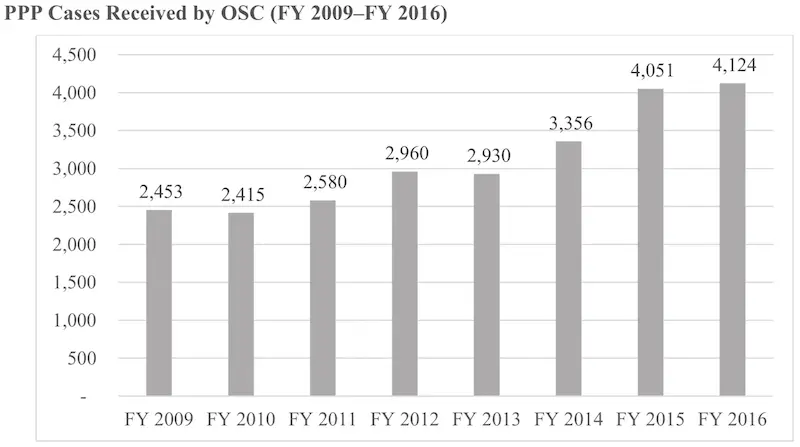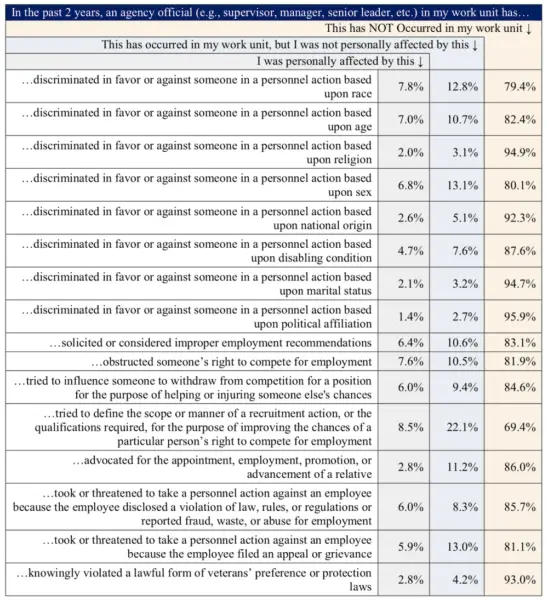Along with the nine Merit System Principles (MSPs), the 14 Prohibited Personnel Practices (PPPs) are among the most critical underpinnings of the merit-based civil service. The Merit System Principles outline what the merit-based civil service is supposed to be, while the Prohibited Personnel Practices describe specific actions that are contrary to merit system principles. Together they provide a basic framework that is intended to ensure that civil service employment is based on fairness, open competition, and merit, rather than favoritism, discrimination, cronyism. The Civil Service Reform Act of 1978 established both the PPPs and the MSPs, and created the Merit Systems Protection Board (MSPB) and the Office of Special Counsel (OSC). The OSC is charged with investigating allegations of PPPs. and may even conduct an investigation on its own where no one makes an allegation. The MSPB may order disciplinary action when an agency does not choose to do it.
So how common are Prohibited Personnel Practices? Complaints from employees and applicants are one of the most common measures, although they do not capture all allegations of PPPs, nor do they capture instances where agencies take action on their own without any involvement of the OSC or MSPB. MSPB’s June 2019 Research Brief, The Perceived Incidence of Prohibited Personnel Practices, compares the results of a 2016 Merit Principles Survey on the subject with the results of a similar 2010 survey.
MSPB found that the number of respondents reporting that they either observed or were personally affected by a PPP increased from 34 percent in 2010 to 46 percent in 2016. They also found that the reported incidence of PPPs varies for each of the 14. The most common complaints were about sex-based discrimination (20.6 percent) and racial discrimination (19.9 percent). Here is MSPB’s table showing the reported incidence of prohibited personnel practices.
In addition to their own survey, MSPB also reported on the number of complaints filed with the Office of Special Counsel. The number has increased from 2,415 in FY 2010 to 4,124 in FY 2016. Here is the full table:

The obvious conclusion is that something has changed to cause the number of PPP complaints to increase. MSPB did not reach a conclusion regarding the reason, and noted that 2010 was a low point in the number of reported PPPs. They went on to say “It is possible more PPPs are occurring. However, it is also possible that employees have become better at recognizing and reporting PPPs as a result of increased efforts to educate them about the PPPs. Several agencies informed us that they believed their workforces had become much better educated about the PPPs. As a result, 2016 may serve as a better baseline for comparison to our next MPS than 2010 did for the 2016 data.”
MSPB also said “Some PPPs are dependent upon a triggering event. For example, a perception of retaliation based upon whistleblowing activity requires a belief that someone engaged in whistleblowing. Likewise, manipulating a recruitment action to the advantage of a person would require a belief that there was a recruitment action.”
When we look just at the number of potential “triggering events” the number of PPPs reported to the OSC is remarkably low given the number of federal workers (2.1 million). The number of new hires was 185K in 2018 (260K in 2016 when the survey was conducted), and the number of involuntary separations was 40K in 2018 (and 57K in 2016). When we add other types of actions that might lead to perceptions of prohibited personnel practices, such as disciplinary actions, the number of potential PPPs goes up dramatically. Add in the number of non-selections that accompany every hire (assume a minimum of 10 per hire, with the actual number probably being much higher), and the number actions that might precipitate a PPP complaint goes up into the millions.
Are prohibited personnel practices that rare? Do we really have only 4,000 people per year who believe they have been the subject of a PPP? The obvious answer is no. Many cases that could be considered to be PPPs are addressed through agency negotiated or administrative grievance procedures. Others are addressed through discrimination complaints. Many are never addressed at all, because the individuals who could file a complaint either do not know about the process for complaining, or do not believe it is worth wasting their time to file a complaint. It is als not that easy to prove a PPP happened. OSC’s FY 2018 Performance and Accountability Report said “In FY 2018, OSC gained 314 favorable actions in its cases, the 2nd highest level in agency history, and 143% over recent agency historical averages (since 2001). This translates into improved accountability and fairness in government, as well as jobs saved, whistleblowers protected, and rights restored.”
The 2018 Federal Employee Viewpoint Survey (FEVS) showed only 66 percent of federal workers believe “I can disclose a suspected violation of any law, rule or regulation without fear of reprisal.” Even worse, only 56 percent agree that “Arbitrary action, personal favoritism and coercion for partisan political purposes are not tolerated.” Arbitrary action, political coercion and favoritism are all potential prohibited personnel practices.
Given the responses to the FEVS, it is clear that far more than four thousand employees believe PPPs are occurring. If they had a better understanding of the law and the ways violations can be addressed, we would most likely see far higher numbers. If they believed there was a likelihood that their complaints would actually make a difference, we would see even more complaints. MSPB was unable to make recommendations to accompany the Research Brief because the Board still does not have a quorum. In their 2016 report, The Merit System Principles: Guiding the Fair and Effective Management of the Federal Workforce, MSPB recommended that, to ensure a merit-based culture that promotes the MSPs and protects against PPPs, it is essential that agencies:
- Select supervisors who have demonstrated their commitment to upholding the high expectations of the Federal merit systems.
- Provide in-depth training regarding the content and applications of the MSPs and PPPs (as well as the potential costs for not adhering to these expectations) to all supervisors at the time of hire and on a regularly recurring basis.
- Ensure that supervisors receive the required training at the time of selection and as needed in subsequent years (at a minimum frequency of every three years as legally mandated). Althoughthe requirements do not specifically mention the MSPs and PPPs, to adequately perform theirduties, this training should cover not only the content of the MSPs and PPPs, but also how they impact their workforce management decisions.
- Ensure that political appointees are well-informed about the practical implications of the MSPs and PPPs and understand the criticality of demonstrating their full support of the Federal meritsystems given their influential leadership role.
- Hold all supervisors, managers and executives accountable for adhering to the MSPs and avoiding PPPs.
- Ensure HRM employees have the expertise to correctly advise regarding the impact of the MSPs on all workforce management decisions.
- Educate employees regarding their rights and responsibilities according to the MSPs and PPPs and ensure that they are aware of the procedures for redress in the event they feel their rights have been violated.
- Understand the dual responsibility to employees and the public to manage the Federal workforce fairly and effectively.
They noted that, even though they cannot issue new recommendations, it is unlikely these recommendations would change.



